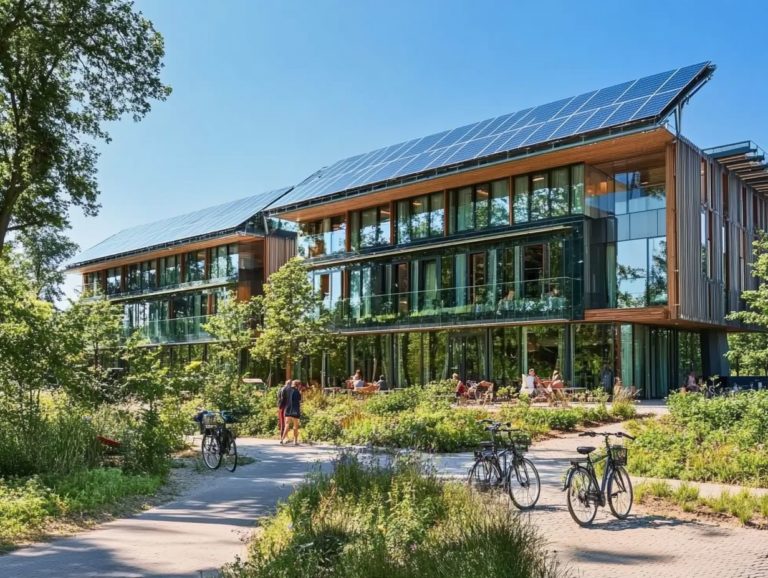Understanding Green Certifications
Green certifications are vital tools for promoting sustainability across various industries, including green building certification, from construction to agriculture. They help identify eco-friendly products and practices while encouraging businesses to adopt more responsible methodologies.
This article explores different types of green certifications, emphasizing their benefits for the environment and public health. It also outlines the steps needed to obtain, maintain, and navigate the certification process.
Additionally, it addresses the challenges and controversies surrounding these certifications, providing insight into their broader impact on the world.
Join us as we delve into the significance of green certifications and discover how they can help shape a more sustainable future.
Contents
- Key Takeaways:
- What are Green Certifications?
- Types of Green Certifications
- Benefits of Green Certifications
- How to Obtain and Maintain Green Certifications
- Challenges and Controversies Surrounding Green Certifications
- Frequently Asked Questions
- What are Green Certifications?
- Why is it important to understand Green Certifications?
- What types of products or services can be Green Certified?
- How can I find out if a product or service is Green Certified?
- Do all Green Certifications have the same standards?
- Are Green Certifications recognized internationally?
Key Takeaways:

- Green certifications promote sustainable practices and help reduce environmental impact.
- Obtaining and maintaining green certifications require meeting specific requirements and processes.
- Criticism and controversies highlight the need for continuous improvement and transparency in the certification process.
What are Green Certifications?
Green certifications are essential benchmarks in sustainable architecture and construction. They represent a commitment to taking care of the environment and adhering to various environmental standards. These certifications demonstrate not only a building’s compliance with eco-friendly practices but also a genuine dedication to reducing ecological footprints and achieving sustainability goals.
With the growing demand for green building certification, now is the time to get involved! Entities such as the U.S. Environmental Protection Agency and organizations like the National Association of Home Builders play crucial roles in guiding you through the certification process.
Certifications like LEED (Leadership in Energy and Environmental Design) and Energy Star are invaluable tools that promote sustainability within the construction industry. LEED emphasizes optimizing energy efficiency, water usage, and material selection while encouraging innovation in sustainable practices. In contrast, Energy Star focuses on a building’s energy performance, inspiring the adoption of energy-efficient systems and designs.
By pursuing these certifications, you not only enhance your corporate responsibility but also foster community building through increased awareness and adoption of sustainable practices, ultimately contributing to a greener future for everyone.
Types of Green Certifications
A variety of green certifications exist to address distinct facets of sustainability and environmental performance. These range from certifications for buildings and products to organic certifications.
Notable certifications like Energy Star and LEED cover a comprehensive array of criteria, all focused on prioritizing energy efficiency, water conservation, and human health.
New certifications such as WELL and the Living Building Challenge are pushing the boundaries of sustainable practices, enhancing the environmental amenities that certified entities offer.
Certifications for Buildings
Certifications for buildings are essential in ensuring you meet environmental standards. They also showcase energy efficiency and sustainability in your design and construction practices.
Notable certifications like LEED, Energy Star, and the Living Building Challenge evaluate various factors, including building materials, ecological footprint, and overall environmental impact. By pursuing these certifications, you’re not only enhancing your building’s market differentiation but also playing a crucial role in reducing greenhouse gas emissions and promoting resource conservation.
When you adopt these certifications, you’re responding to the growing demand for environmentally responsible construction practices that prioritize health and safety. For instance, LEED provides a structured approach to sustainability, rewarding features like renewable energy sources and water conservation systems.
Energy Star, on the other hand, focuses on optimizing energy use. This ensures your buildings operate at peak efficiency while keeping operating costs low. If you re focused on occupant health and well-being, WELL Building certification integrates elements such as air quality and natural lighting into your designs.
Collectively, these certifications cultivate a culture of sustainability, reducing energy consumption and enhancing the quality of life for everyone who inhabits these spaces.
Product Certifications
Product certifications are vital in ensuring that the goods you choose meet stringent environmental standards for both safety and performance. Certifications like Green Seal and EcoLogo focus on various aspects of product effectiveness, such as reducing toxic emissions and encouraging green cleaning practices.
The USDA BioPreferred program highlights products made from renewable resources, enabling you to make informed choices that reflect your sustainability values.
These certifications act as your guide in the world of environmentally conscious shopping. They lead you to products that fulfill your everyday needs while minimizing your ecological footprint and supporting sustainable building practices.
By opting for items adorned with these labels, you actively support sustainable practices crucial in the fight against climate change and the protection of natural resources.
The transparency these certifications offer builds trust. You can feel confident that your purchases contribute to a greener planet. Embracing these certifications is a significant step toward nurturing a healthier environment and fostering responsible consumer habits.
Organic Certifications

Organic certifications are essential for ensuring that agricultural products are cultivated in environmentally friendly and sustainable ways. They adhere to rigorous standards that promote environmental protection and resource conservation.
When you choose certified organic products, you’re guaranteed they are free from synthetic pesticides and fertilizers. This supports biodiversity and ecological integrity in farming practices, ultimately enhancing community health and well-being.
The rise of organic certifications is a direct reflection of your growing demand for transparency and ethical sourcing in food and agricultural products.
The standards set by organic certification bodies are instrumental in guiding farmers toward methods that minimize soil degradation, conserve water, and protect air quality. By opting for organic practices, farmers contribute to healthier ecosystems and benefit the larger global community.
This commitment to sustainable agriculture fosters resilience in farming systems, enabling them to withstand climate challenges while advocating for reduced reliance on non-renewable resources.
Ultimately, embracing organic certifications aligns agricultural practices with a broader commitment to environmental stewardship. This underscores the interdependence of healthy farming, consumer awareness, and a balanced ecosystem.
Benefits of Green Certifications
The advantages of green certifications extend beyond basic environmental standards. They significantly impact health and safety, lead to substantial energy cost savings, and contribute to community building.
By embracing sustainable practices recognized by certifications like LEED, you can reduce your carbon footprint, which is the total amount of greenhouse gases produced directly and indirectly by an individual or organization. This also enhances the well-being of building occupants through improved indoor air quality and less exposure to things in the environment that can harm us.
These certifications also foster a sense of corporate responsibility and environmental stewardship, inspiring communities to embrace sustainability as a shared value.
Environmental Impact
The impact of green building certifications is significant. They play a crucial role in reducing greenhouse gas emissions and the overall ecological footprint of buildings. Certifications like Energy Star and the Living Building Challenge advocate for resource conservation practices. They encourage developers and builders to prioritize energy efficiency and sustainable materials in design and construction.
This collective effort not only reduces environmental hazards but also promotes a healthier planet for future generations.
For instance, Energy Star certified buildings can cut greenhouse gas emissions by up to 35%. These certifications offer tangible benefits in the fight against climate change. The Living Building Challenge further encourages projects to achieve net-zero energy, meaning a building produces as much energy as it uses in one year. This commitment enhances resource efficiency and strengthens community resilience, showing how environmentally responsible choices can lead to significant advancements in sustainability.
Take action now! By prioritizing these certifications, you help create a greener future.
Health and Safety Benefits
Green building certifications offer remarkable health and safety benefits. They ensure that indoor spaces promote well-being while minimizing exposure to environmental hazards and toxic emissions. Following the rigorous guidelines set by certifications like WELL and LEED can improve air quality and make sure that materials are safe for everyone.
These standards enhance physical health and nurture mental well-being through thoughtfully designed areas that encourage community and connection.
Certifications implement strategies such as improved ventilation systems that effectively filter out airborne pollutants. They also promote the use of non-toxic paints and sustainable materials to reduce harmful emissions. Integrating natural light and greenery into designs creates environments that foster tranquility, positively impacting mood and productivity.
Safe building practices also support the development of healthier communities. They promote walking and cycling, reduce pollution, and lower dependence on vehicles. In the end, these efforts contribute to healthier individuals and a more vibrant, sustainable environment for future generations.
How to Obtain and Maintain Green Certifications
Securing and maintaining green certifications requires a thorough understanding of the certification process. This process includes specific requirements and ongoing assessments to ensure compliance with environmental standards.
This journey often requires collaboration among various stakeholders, including architects, contractors, and maintenance teams. All must align with guidelines set by certifying entities like the U.S. Environmental Protection Agency or the National Association of Home Builders.
Careful planning and management are essential for navigating the complexities of certification and maintaining high standards once the building is operational.
Explore more about understanding responsible travel certifications and get involved in sustainable practices!
Requirements and Processes

Achieving green building certifications requires you to meet specific benchmarks and adhere to established guidelines throughout the design, construction, and maintenance phases.
Each certification, whether it s LEED or Energy Star, comes with unique criteria that you must meticulously document and verify through a rigorous certification process.
Successfully navigating this process ensures that your buildings not only meet current environmental standards but also maintain sustainability over their lifecycle.
Stakeholders play a pivotal role in this endeavor. You ll need architects, engineers, and contractors to collaborate closely, aligning their efforts toward achieving your goals.
Comprehensive documentation is essential to demonstrate compliance with the outlined standards. This documentation covers everything from analyzing energy use in buildings to material sourcing and waste management plans.
Maintenance practices are critical, as they can directly affect your building’s efficiency and environmentally friendly status. Regular audits and updates are key to preventing any decline in certification, ensuring long-term benefits for both occupants and the environment.
Challenges and Controversies Surrounding Green Certifications
Understanding the challenges surrounding green building certifications is crucial for anyone aiming for sustainability. Despite the advantages, several challenges and controversies linger regarding their methodologies and actual environmental impact.
Many critics raise concerns about the effectiveness of certain certification standards, suggesting they may fall short in addressing essential issues such as carbon footprint reduction and social equity within community building.
The complexity of certification processes can deter smaller developers, creating barriers to entry on the journey toward sustainability.
Criticism and Potential Solutions
Criticism surrounding green building certifications often focuses on their perceived inability to accurately measure ecological footprints and the true environmental stewardship of certified buildings. To tackle these issues, consider revising certification methodologies to include more rigorous assessments of carbon emissions and resource usage, along with increasing transparency regarding the sustainability practices of certified entities.
By adapting to these critiques, the green certification landscape can evolve, benefiting both the environment and building occupants.
Many argue that the absence of standardized metrics results in inconsistent evaluations, undermining trust among stakeholders. Implementing a universal framework for performance assessment can help mitigate these inconsistencies and foster accountability.
Encouraging third-party audits can bolster integrity, ensuring that claims made by certified buildings are substantiated. Engaging stakeholders in the certification process through regular feedback loops could address concerns while promoting continuous improvement.
These measures not only enhance the credibility of green certifications but also align them more closely with the genuine sustainability goals championed by many advocates.
Frequently Asked Questions
What are Green Certifications?
Green Certifications are third-party assessments that verify and confirm the sustainability and environmental performance of a product, service, or building.
Why is it important to understand Green Certifications?

Understanding Green Certifications can help individuals and organizations make informed decisions about their purchases and operations, contributing to a more sustainable future.
What types of products or services can be Green Certified?
Any product or service with a significant environmental impact can be Green Certified. This includes everything from household appliances and cleaning products to hotels and restaurants.
How can I find out if a product or service is Green Certified?
You can look for the Green Certification label or logo on the product or service, or ask the provider directly for information on their Green Certification status.
Do all Green Certifications have the same standards?
Green Certifications vary in their criteria and standards. Some focus on specific aspects of sustainability, while others have broader and stricter requirements. This means that it’s essential to choose the right certification for your needs!
Are Green Certifications recognized internationally?
Many Green Certifications are recognized internationally. They allow for easy comparison of products and services across different countries. Choosing a globally recognized certification can boost your credibility and market reach!






